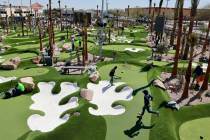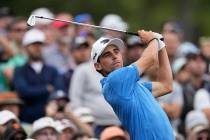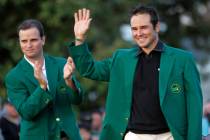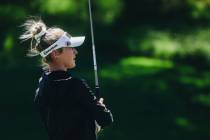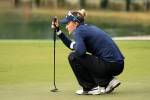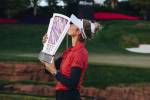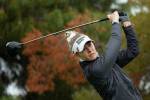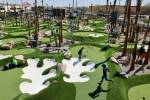Relax the small muscles when swinging golf club
Swinging a golf club involves the movement of three distinct muscle groups in a very natural and athletic sequence. Those muscle groups are the lower torso from the waist down, the upper torso from the waist up and the small muscle group that includes the arms, wrists and hands.
In the correct and natural sequence of movement the upper torso turns to execute the back swing. Once the back swing is completed, the lower torso turns to execute the down and through, or forward swing. We all know these two turns as basic golf swing movements. The sequence of those movements is very much the same as throwing a ball. But, what then is the role of the small muscle group? I believe those small muscles should be followers, not leaders. What do I mean by that?
It's not that the arms, wrists and hands aren't active, but they should not be initiating any of the sequential movement. What I see in so many of my students is a movement of the hands and wrists to initiate the back swing. This immediately increases grip pressure, which in turn causes tension in the wrists, which in turn causes tension in the arms.
The result is a small muscle group that is incapable of swinging the club freely. The tension in those small muscles not only slows down the club head, but now causes the player to have to cock the wrists on the back swing and then uncock the wrists, with correct timing, in order to release and square the club face at impact.
I don't even like the use of the phrase "cock your wrists" in the golf swing. I do like the word hinge. If the hands remain soft on the club and the wrists are relaxed and supple, the weight of the club head will hinge the wrists in the back swing and unhinge them in the down swing, and do it at the correct time as the body is making the two turns. The small muscles are simply reacting to the movement of the large muscles and to the weight of the club head.
What about squaring the club face through impact? As I mentioned above, grip pressure and tension in the wrists and arms forces the golfer to make the club face come to square.
Take away that pressure and tension, and the club will actually square itself. This is because the toe of the club is heavier than the heel in relation to its center of gravity, because it's further from the axis, which is the shaft. This is centripetal force, and it's built in to the club head.
To feel this force, just hold a golf club softly and swing it freely at shoulder level on a horizontal plane. You will feel the club head start to turn, almost violently, as it approaches your center. That's the club head squaring itself.
As you work on a more relaxed small muscle swing, be aware that any flaws in your grip and positioning of the hands in relation to neutral will greatly affect the position of the club face through impact. A good grip, positioned close to neutral will produce the best results. If you have a bad grip, please don't make a good swing -- they don't go together.
As the great teacher John Jacobs, said "The golf swing is simply two turns with a swish in the middle."
Relax those small muscles and you will make a faster swish. There's a good drill that will help you feel and hear this. Take a fairway wood or long iron, turn it upside down, grip the shaft near the club head, and make swings while listening for that swishing sound. You'll find that the lighter you grip the shaft and the more relaxed you keep your wrists, the louder the swish.
We want to achieve effortless power, not powerful effort.
Tom Utsler is a PGA member with 20 years of experience teaching players of all skill levels. He is currently a full-time instructor at Angel Park Golf Club. For information, call 404-432-2019 or email tom.utsler72@gmail.com.










